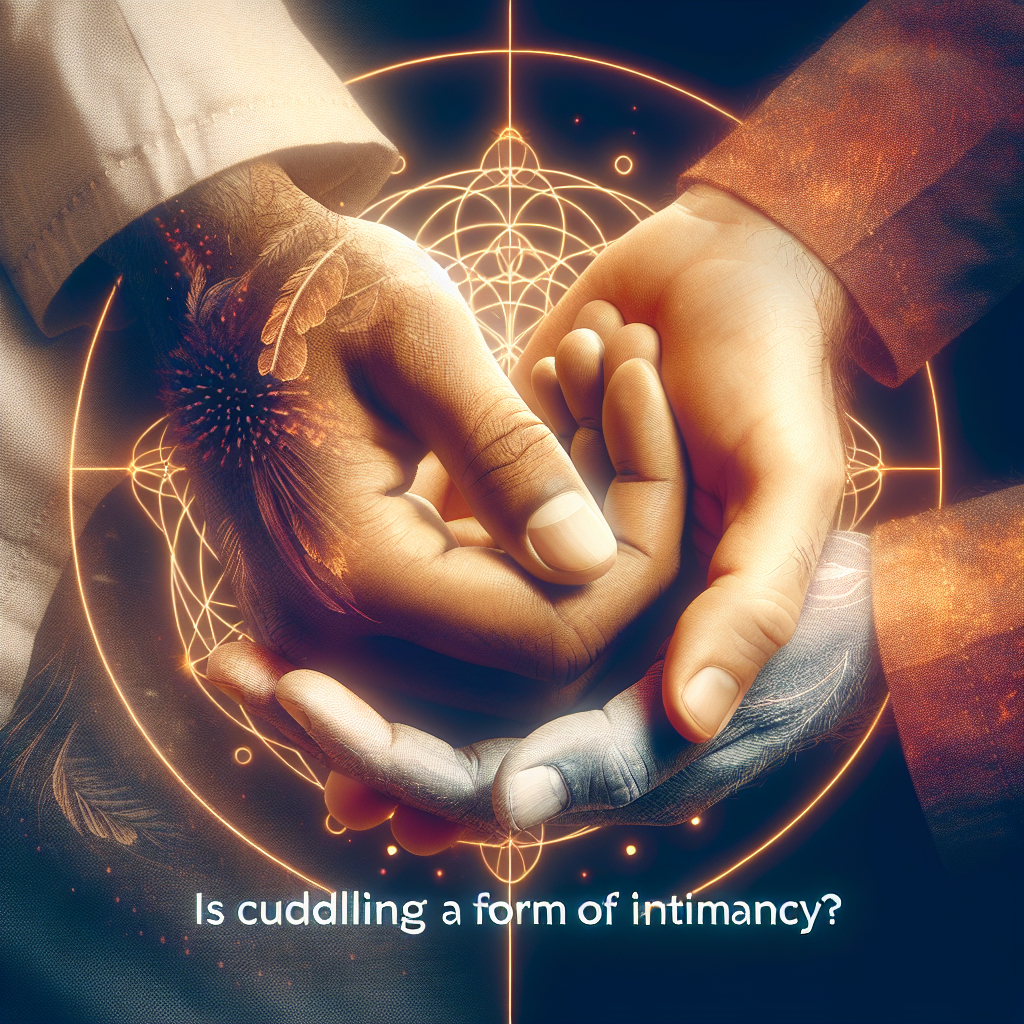So you’ve found yourself in the cozy embrace of someone special, wrapped up in their arms, sharing a tender moment. But have you ever wondered, is cuddling a form of intimacy? In this article, we will explore the deep connection that can be fostered through the act of cuddling and uncover the emotional and physical benefits it brings. Whether you’re a cuddle enthusiast or skeptical about its significance, prepare to discover the power of this simple yet profound gesture.
Is Cuddling A Form Of Intimacy
When it comes to human connection, there are various forms of intimacy that people seek. One of these forms is cuddling, which can evoke feelings of warmth, comfort, and closeness. Cuddling is not just about physical touch but also about the emotional connection that it can create. In this article, we will explore the concept of cuddling as a form of intimacy, different types of intimacy, the role of cuddling in fostering intimacy, the benefits of cuddling, cultural and gender perspectives on cuddling, cuddling in different relationship contexts, and factors influencing cuddling preferences.

Defining Cuddling
Cuddling can be defined as a form of physical closeness that involves non-sexual affection and an emotional connection between individuals. It usually involves embracing, holding, and snuggling with another person in a way that promotes feelings of comfort and security.
Physical Closeness
At its core, cuddling revolves around physical closeness. It is the act of physically being close to another person, often in a gentle and affectionate manner. This physical proximity can create a sense of safety and comfort, allowing individuals to feel more connected to one another.
Non-sexual Affection
While physical affection and sexual intimacy often go hand in hand, cuddling focuses primarily on non-sexual affection. It is an intimate act that does not necessarily lead to sexual activity. Cuddling is about nurturing a sense of emotional connection and expressing love, care, and affection without the expectation of sexual activity.
Emotional Connection
Cuddling goes beyond physical touch and can foster an emotional bond between individuals. It creates an opportunity for individuals to feel emotionally connected and supported by each other. Through cuddling, people can share their vulnerabilities, seek comfort, and enhance their emotional connection.
Exploring Different Types of Intimacy
To better understand cuddling as a form of intimacy, it is important to explore the different types of intimacy that exist. These include physical intimacy, emotional intimacy, and intellectual intimacy.
Physical Intimacy
Physical intimacy involves the exploration and expression of physical affection between individuals. It encompasses behaviors such as cuddling, hugging, holding hands, kissing, and sexual activity. Physical intimacy plays a vital role in relationships as it helps strengthen the emotional connection between partners.
Emotional Intimacy
Emotional intimacy refers to the deep emotional connection between individuals. It involves sharing feelings, thoughts, and experiences in a vulnerable and authentic manner. Emotional intimacy allows individuals to feel understood, supported, and validated by their partner.
Intellectual Intimacy
Intellectual intimacy involves the sharing of ideas, thoughts, and intellectual pursuits between individuals. It is about engaging in stimulating conversations, discussing shared interests, and appreciating each other’s intellectual capabilities. Intellectual intimacy helps create a sense of mental compatibility and can strengthen the bond between individuals.
Understanding Intimacy
Intimacy is a multidimensional concept that encompasses various elements. To truly understand the role of cuddling in intimacy, it is important to explore the key components of intimacy and the significance it holds in relationships.
Key Components of Intimacy
Intimacy is often characterized by trust, vulnerability, emotional connection, and mutual understanding. It involves a sense of closeness and familiarity with another individual. The key components of intimacy include physical touch, emotional support, open communication, empathy, and shared experiences.
Importance of Intimacy in Relationships
Intimacy is crucial in relationships as it fosters a sense of security, emotional fulfillment, and connection between partners. It allows individuals to feel valued, accepted, and loved. Intimacy promotes relationship satisfaction, strengthens the bond between partners, and lays the foundation for a healthy and fulfilling relationship.
The Role of Cuddling in Intimacy
Cuddling plays a significant role in fostering intimacy within relationships. It operates as both a form of physical intimacy and a way to nurture emotional intimacy.
Cuddling as a Form of Physical Intimacy
Cuddling involves physical touch, which is an essential aspect of physical intimacy. When individuals cuddle, they experience the warmth and comfort that comes from being in physical contact with another person. It creates a safe and secure space for individuals to relax, let their guard down, and feel physically connected to their partner.
Cuddling as a Way to Foster Emotional Intimacy
Cuddling goes beyond physical touch and has the power to deepen emotional intimacy. Through cuddling, individuals can express their love, care, and affection non-verbally. It creates an environment where emotional barriers can be broken down, allowing individuals to feel emotionally supported and connected to their partner.

Benefits of Cuddling
Cuddling offers a range of benefits that extend beyond simply feeling good in the moment. These benefits contribute to overall well-being and can enhance the quality of relationships.
Bonding and Connection
Cuddling promotes bonding and connection between individuals. The act of physical closeness releases hormones such as oxytocin, often referred to as the “cuddle hormone.” Oxytocin plays a significant role in strengthening social bonds and fostering feelings of love, trust, and attachment.
Reduced Stress and Anxiety
Cuddling has the power to reduce stress and anxiety. The physical touch and closeness experienced during cuddling can trigger the release of endorphins, which are natural mood-boosting chemicals in the brain. Cuddling can also lower levels of cortisol, a hormone associated with stress.
Increased Oxytocin Levels
Cuddling stimulates the release of oxytocin, which has numerous health benefits. Oxytocin can reduce blood pressure, improve heart health, boost the immune system, and promote overall well-being. Increased levels of oxytocin contribute to feelings of happiness and contentment.
Cultural and Gender Perspectives on Cuddling
The perception and acceptance of cuddling can vary across different cultures and genders. Cultural norms and attitudes, as well as individual preferences, influence how cuddling is viewed and practiced.
Cultural Norms and Attitudes Towards Cuddling
Cultural norms and attitudes towards physical affection and intimacy differ worldwide. Some cultures may place a greater emphasis on physical touch and cuddling as a way to express love and affection, while others may have more reserved attitudes towards public displays of affection and physical closeness.
Gender Differences in Cuddling Preferences
There can be gender differences in cuddling preferences. Societal expectations and gender roles may influence how individuals perceive cuddling and feel comfortable engaging in it. However, these preferences are not fixed and can vary greatly among individuals.

Cuddling in Different Relationship Contexts
Cuddling occurs in various relationship contexts, each with its unique dynamics and significance.
Cuddling in Romantic Relationships
Cuddling is often associated with romantic relationships, where it plays a vital role in building and maintaining intimacy. It strengthens the emotional connection between partners, fosters a sense of security, and enhances relationship satisfaction.
Cuddling in Platonic Friendships
Cuddling can also occur in platonic friendships. Some individuals may feel comfortable cuddling with their close friends as a way to provide emotional support, seek comfort, or simply enjoy the physical closeness in a non-romantic context. The boundaries and expectations of cuddling in these friendships can vary based on individual comfort levels and mutual consent.
Family Cuddling
Cuddling is a common practice within families, especially among parents and children. It promotes feelings of love, security, and nurturance. Family cuddling can contribute to a strong bond between family members and create a supportive and affectionate environment within the family unit.
Factors Influencing Cuddling Preferences
Individuals’ preferences for cuddling can be influenced by various factors, including comfort levels, personal history, and communication.
Individual Comfort Levels
Comfort levels with physical touch and cuddling can vary among individuals. Some people may naturally be more inclined towards close physical contact, while others may prefer more personal space. Personal comfort levels should be respected and communicated within relationships.
Personal History and Past Experiences
Past experiences and personal history with cuddling can shape individuals’ preferences. Positive experiences with cuddling may lead to a greater inclination towards cuddling, while negative experiences or trauma may influence individuals to be more hesitant or reserved when it comes to physical closeness.
Communication and Consent
Open and honest communication is essential when it comes to cuddling. It is important to establish consent and boundaries within relationships to ensure that both partners feel safe and comfortable. Regular communication about preferences, desires, and comfort levels can help foster a positive cuddling experience.

Conclusion
In conclusion, cuddling is indeed a form of intimacy that encompasses physical closeness, non-sexual affection, and emotional connection. It plays a significant role in fostering both physical and emotional intimacy within relationships. Cuddling offers numerous benefits such as bonding, reduced stress, and increased levels of oxytocin. Cultural and gender perspectives on cuddling may vary, and cuddling can occur in different relationship contexts. Factors influencing cuddling preferences include individual comfort levels, personal history, and effective communication. Ultimately, cuddling can be a powerful tool in strengthening human connections and nurturing intimacy in various relationships.

